Fourth Quarter 2017 Real Estate Market Report: Dutchess County Overview
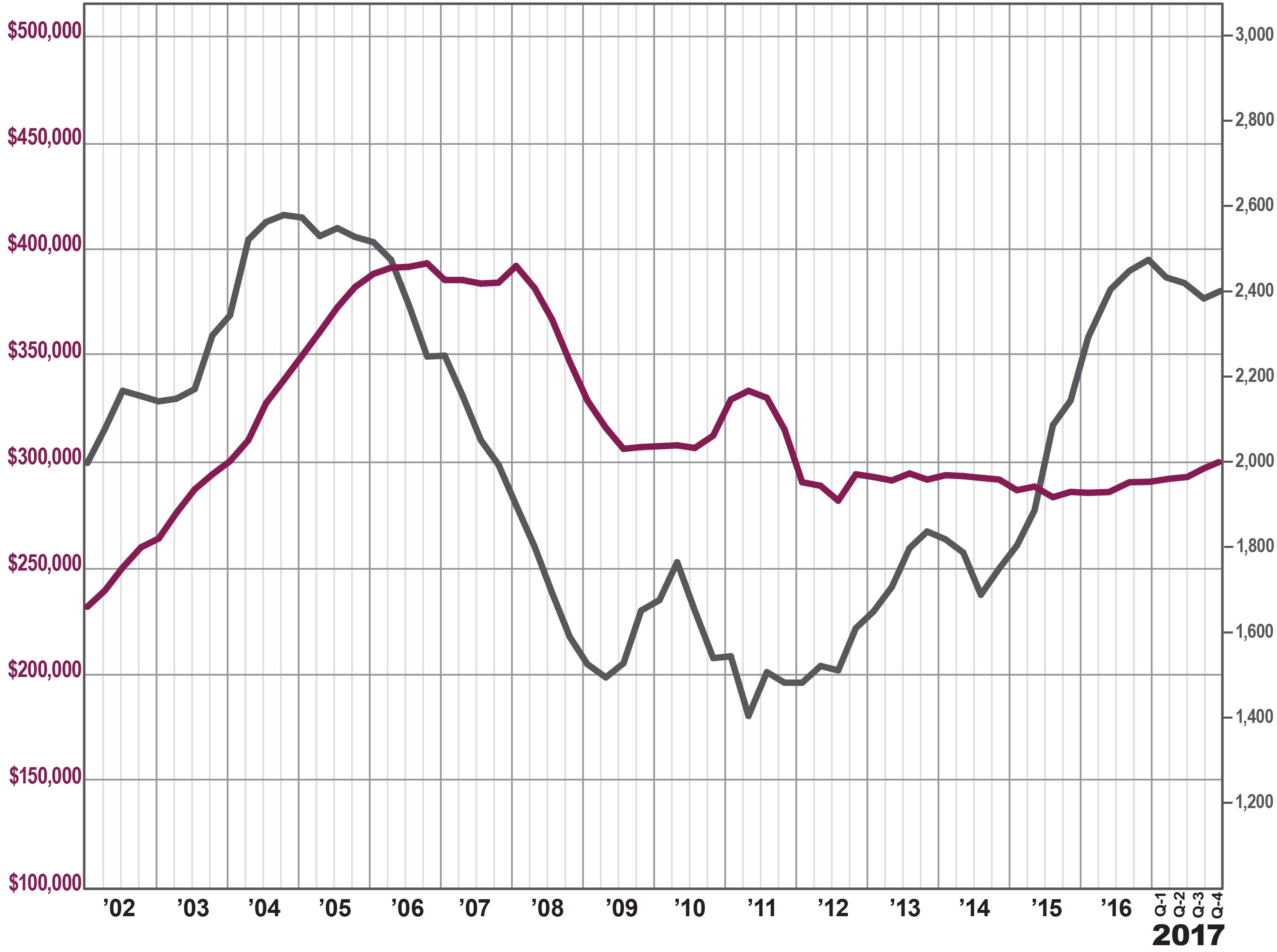
 The Dutchess County housing market finished the year strong, with the first clear signs of meaningful price appreciation in years.
The Dutchess County housing market finished the year strong, with the first clear signs of meaningful price appreciation in years.
Sales. Dutchess sales rose slightly in the fourth quarter, up just about 1%. For the year, sales were down over 4%, which reflects low levels of inventory more than a lack of demand. Dutchess definitely needs more listings, some “fuel for the fire” to accommodate strong buyer demand.
Prices. Home prices continued to show the effects of declining inventory coupled with strong demand, with pricing up almost 3% on average, almost 8% at the median, and almost 3% in the price‑per‑square foot. For the calendar year, Dutchess experienced meaningful price appreciation, with the average up almost 3%, the median rising 4%, and the price‑per‑square‑foot up over 3%. Average prices in Dutchess have now gone up for two straight years, following four straight years of declines, where prices were bouncing around the bottom.
Negotiability. Dutchess homes are continuing to sell more quickly and for closer to the asking price, reflecting the negotiating leverage that sellers are getting in this market.
Condos. The condo market was mostly down for the quarter and flat for the year. In the fourth quarter, sales were down over 7%, and prices were down over 6% on average and almost 5% at the median. For the year, sales and prices were mostly flat, but the negotiability indicators signaled that Dutchess condos were moving into a seller’s market.
Going forward, we believe that the Dutchess market will experience a robust 2018. With tightening inventory, a stable economy, near‑historically‑low interest rates, and homes still priced at appealing 2003‑04 levels, Dutchess is likely to see meaningful price appreciation throughout the year.
To learn more about Better Homes and Gardens Real Estate Rand Realty, visit their website and Facebook page, and make sure to “Like” their page. You can also follow them on Twitter.
Fourth Quarter 2017 Real Estate Market Report: Putnam County Overview
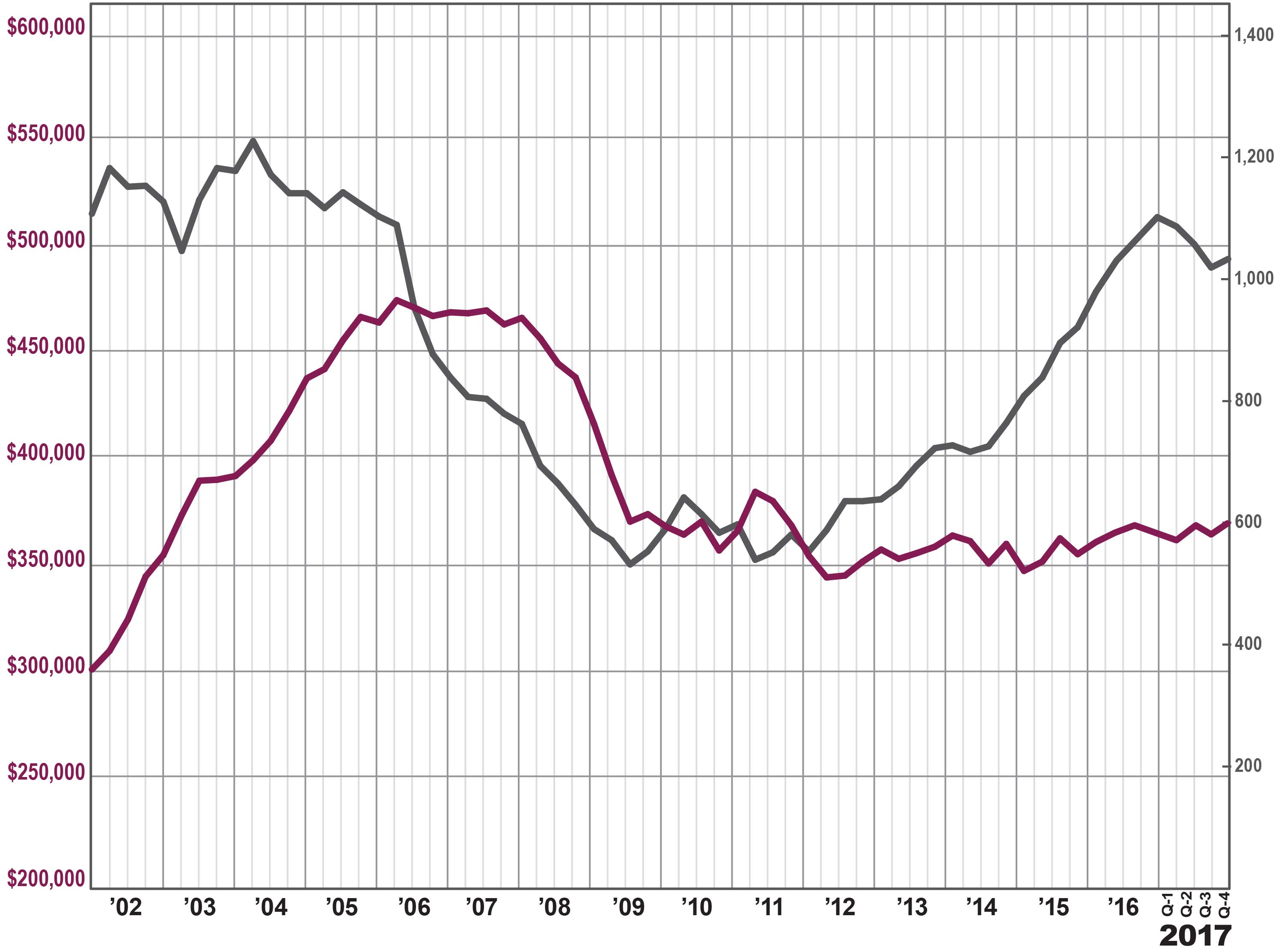
 The Putnam County housing market finished 2017 with a flourish, as low levels of inventory drove prices up dramatically.
The Putnam County housing market finished 2017 with a flourish, as low levels of inventory drove prices up dramatically.
Sales. Putnam single‑family home sales were up a tick for the quarter, following three straight quarters of decline. For the calendar year, sales were down over 7%, marking the first time in over five years where the yearly sales have gone down. This is not, though, due to a lack of demand, but rather a sign of the impact of severely low levels of inventory.
Prices. This lack of inventory drove a major spike in pricing in the fourth quarter, with prices up dramatically across the board: up almost 11% on average, over 8% at the median, and over 10% in the price‑per‑square‑foot. This was by far the largest quarterly increase in over 12 years, since the height of the last seller’s market. And one good quarter saved the year, with 2017 prices finishing up just a bit for the second year in a row.
Inventory. Inventory continued to tighten, falling over 6% and now down well below the six‑month level that usually denotes a tightening seller’s market. This lack of available homes is what’s been holding back sales, since we don’t have enough “fuel for the fire” to keep the market going.
Negotiability. The negotiability indicators support the idea that a seller’s market is emerging, with the listing retention rate up just a tick and the days‑on‑market continuing to fall.
Condos. The smallish condo market surged in the fourth quarter, with sales up over 18% and prices up just a tick. For the year, though, sales were down sharply and prices gave back a little, even while inventory continued to fall.
Going forward, we believe the Putnam County market will thrive in 2018 as a robust seller’s market. Demand will stay strong, with interest rates near historic lows, prices still at attractive 2004‑05 levels, and a strengthening economy. And if inventory remains low, prices will likely continue to appreciate meaningfully through the new year.
To learn more about Better Homes and Gardens Real Estate Rand Realty, visit their website and Facebook page, and make sure to “Like” their page. You can also follow them on Twitter.
Fourth Quarter 2017 Real Estate Market Report: Westchester County Overview
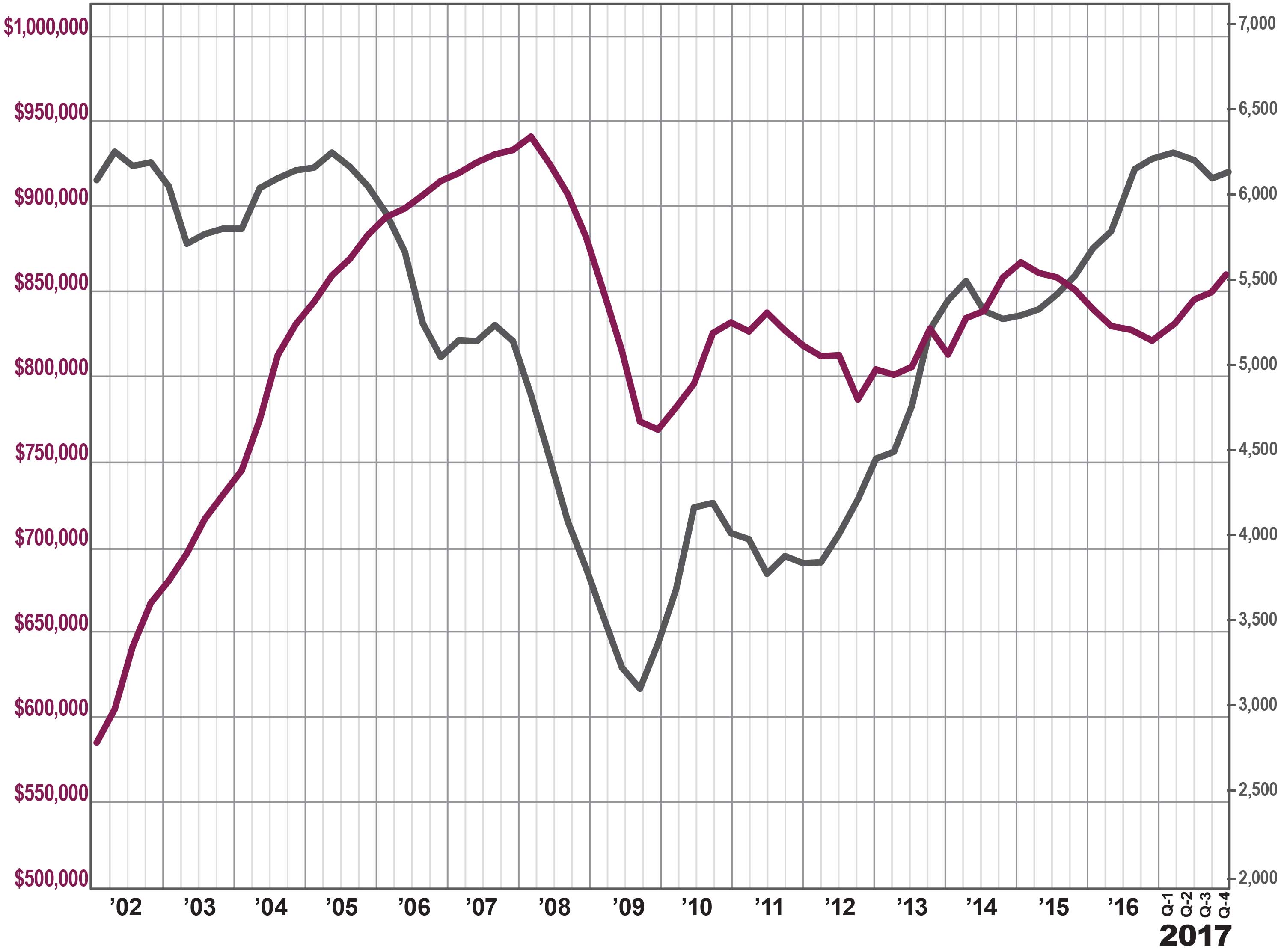
 The Westchester housing market finished strong in 2017, with a surge in prices even while a lack of inventory held back sales growth.
The Westchester housing market finished strong in 2017, with a surge in prices even while a lack of inventory held back sales growth.
Sales. Home sales were up just a tick, rebounding a bit from their sudden decline in the third quarter. You can see the continued impact of a lack of inventory, though, with sales down almost 2% for the full year. Still, with over 6,100 sales for the year, transactions in Westchester are now at their highest level since 2005, and almost double where they were at the bottom of the market in 2009.
Prices. With inventory this low, and demand remaining high, we are starting to see some acceleration in price appreciation. Prices were up 5% on average and at the median for the quarter, and for the year finished up 4% on average and 3% at the median. This is welcome news for Westchester homeowners, who saw small average and median price drops over the past two years. That said, the average and median price are still at 2005 levels, without even accounting for inflation.
Negotiability. The negotiability indicators continue to signal the emergence of the seller’s market. Inventory declined again, falling over 8% and now at the lowest level of inventory we have had in Westchester in over 12 years, since the height of the last seller’s market. Similarly, for the full year, the listing retention rate was up, and the days‑on‑market was down, indicating that homes are selling more quickly and for closer to the asking price.
Condos and Coops. The condo and coop market was more uneven. The condo market was sizzling, with average prices up over 8% in the quarter and almost 5% for the year. Sales were down, but that’s certainly because inventory is below the three‑month level. The coop market was more mixed, with sales up for the year and prices relatively flat, even while inventory fell to the three‑month level.
Going forward, we expect that Westchester will continue to see meaningful price appreciation in 2018, especially if inventory remains tight. With pricing near 2005 levels and interest rates near historic lows, we believe that the seller’s market will thrive in the new year.
To learn more about Better Homes and Gardens Real Estate Rand Realty, visit their website and Facebook page, and make sure to “Like” their page. You can also follow them on Twitter.
Fourth Quarter 2017 Real Estate Market Report: Orange County Overview
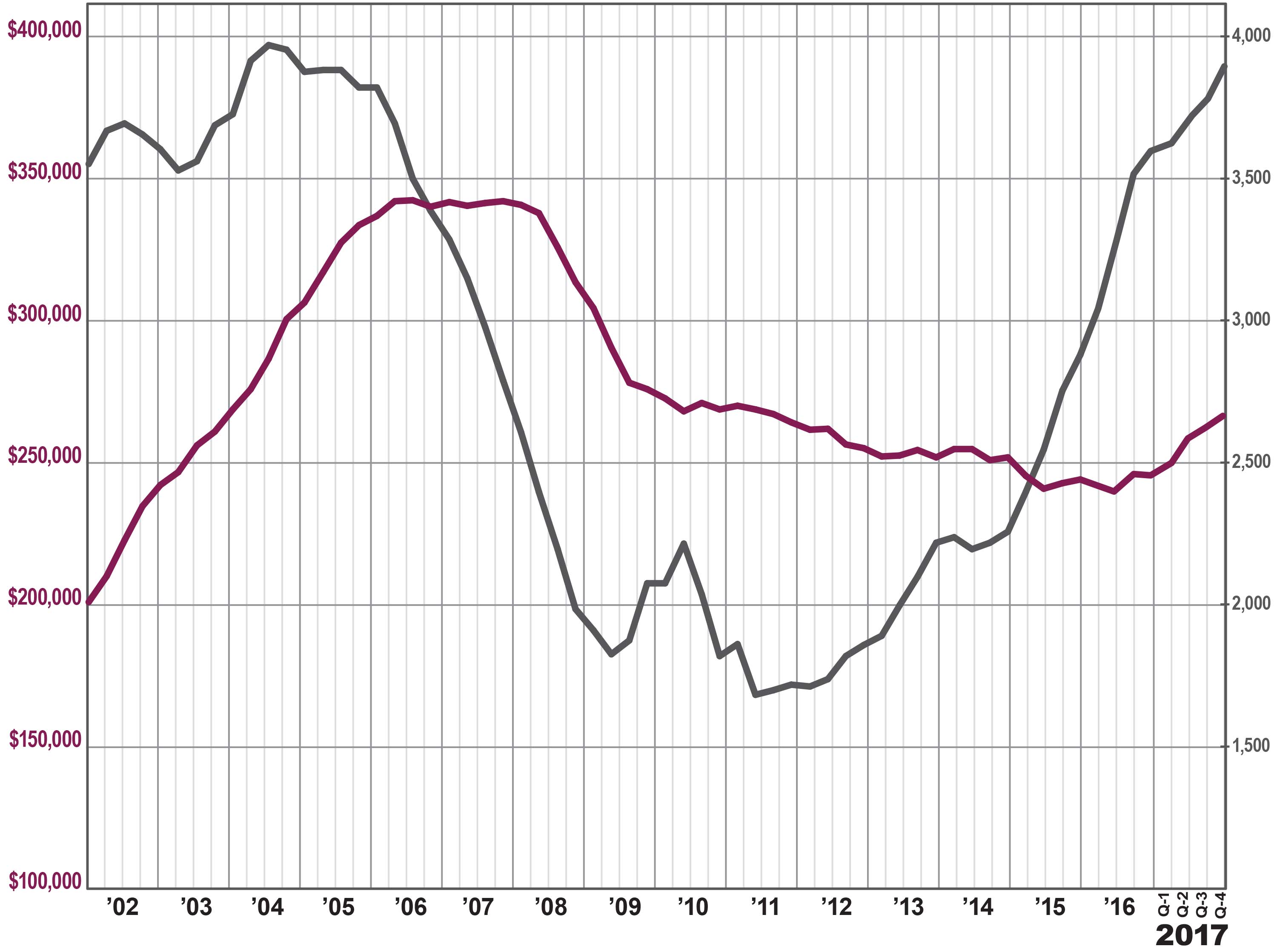
 The Orange County housing market surged again in the fourth quarter of 2017, finishing a robust year with a flourish.
The Orange County housing market surged again in the fourth quarter of 2017, finishing a robust year with a flourish.
Sales. Orange sales spiked in the fourth quarter, rising almost 15%. Quarterly transactions have now gone up in 13 straight quarters and 22 out of the last 23. Similarly, sales were up almost 8% for the calendar year, marking the sixth straight year of increasing transactions. Indeed, the 3,837 calendar year sales was the highest yearly total since 2004, at the height of the last seller’s market, and is more than double the sales totals from the bottom of the market in 2009.
Prices. These continued increases in buyer demand are finally having a sustained impact on pricing. Home prices rose again in the fourth quarter, up 3% on average, over 7% at the median, and almost 5% in the price‑per‑square‑foot. And for the first time in years, prices were up meaningfully for the calendar year, rising almost 5% on average, almost 6% at the median, and over 3% in the price‑per‑square‑foot. Price appreciation was a long time coming in Orange County, but it’s finally here.
Negotiability. The available inventory continues to tighten, down almost 27% and now well below the six‑month level that signals a seller’s market. Meanwhile, homes are selling more quickly and for closer to the asking price. Indeed, over the past year, the days‑on‑market average fell 23 days, and the listing retention rate rose over a full point.
Condos. The condo market absolutely exploded in the fourth quarter, continuing a welcome trend that we finally started to see this year. Sales were up a whopping 37% and prices spiked almost 13% on average and 14% at the median. For the year, sales were up almost 23% and prices were up sharply. This marked the first year where condo prices have gone up since 2007 ‑‑ over 10 years ago.
Going forward, we believe that the Orange County housing market is poised for a great year: demand is high, prices are still at attractive 2003‑04 levels, interest rates are at historic lows, and the economy is generally strong. With inventory continuing to decline, we expect to see significant sales growth and meaningful price appreciation throughout 2018.
To learn more about Better Homes and Gardens Real Estate Rand Realty, visit their website and Facebook page, and make sure to “Like” their page. You can also follow them on Twitter.
Fourth Quarter 2017 Real Estate Market Report: Rockland County Overview
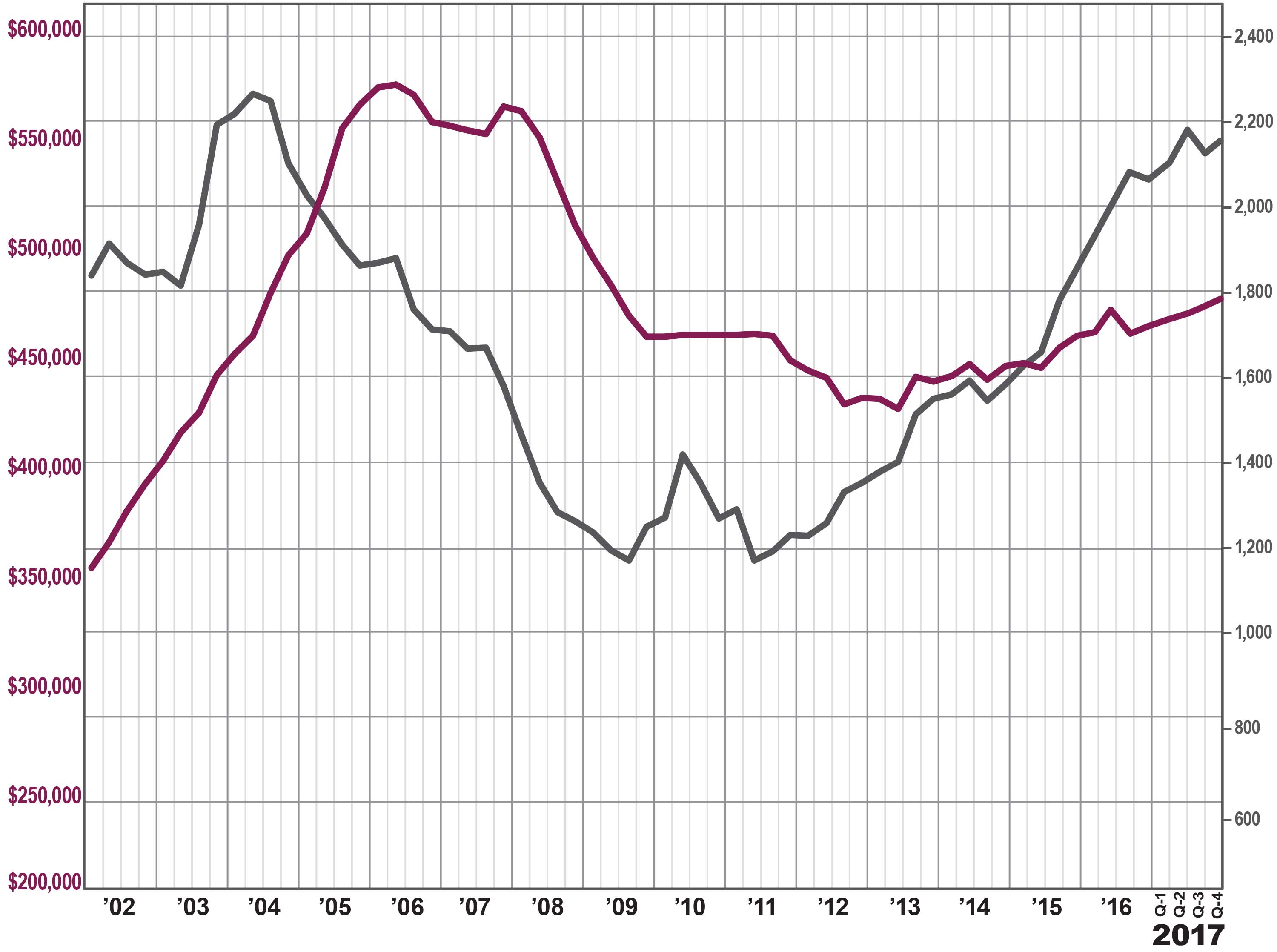
 The Rockland County housing market capped off a strong 2017 with a robust finish, with both prices and sales up significantly in the fourth quarter.
The Rockland County housing market capped off a strong 2017 with a robust finish, with both prices and sales up significantly in the fourth quarter.
Sales. After a decline in the third quarter, sales roared back in the fourth, rising almost 11%. This drove the yearly transaction total up almost 5% for the year, marking the sixth straight calendar year of increasing sales. Indeed, the 2,140 single‑family sales in 2017 was the highest calendar year total since 2003, at the height of the last seller’s market.
Prices. These sustained increases in buyer demand have started to make a dramatic impact on prices, which were up across the board in the fourth quarter: up almost 6% on average, 4% at the median, and over 5% in the price‑per‑square‑foot. And for the calendar year, prices were up significantly, rising about 4% on average, at the median, and in the price‑per‑square‑foot. Rockland prices have now gone up for five straight calendar years, and are now up 15% from the bottom of the market in 2012. Still, though, pricing is at 2005 levels, without even accounting for inflation, so we have significant room for growth.
Negotiability. Inventory continued to fall in the fourth quarter, dropping over 18% and now down to just about four months of inventory. Similarly, the listing retention rate rose and the days‑on‑market fell sharply again, indicating that sellers are increasingly gaining negotiating leverage with buyers in this full‑blown seller’s market.
Condos. The Rockland condo market also finished strong, with both sales and prices up significantly for the year. Condo inventory is now down to almost three months, which indicates we’re looking at more price appreciation in 2018.
Going forward, we expect that buyer demand in Rockland will continue to drive prices up and inventory down. With prices still at attractive 2004 levels, interest rates near historic lows, inventory falling, and the economy generally strengthening, we believe that this sustained buyer demand will drive meaningful price appreciation through 2018.
To learn more about Better Homes and Gardens Real Estate Rand Realty, visit their website and Facebook page, and make sure to “Like” their page. You can also follow them on Twitter.
Fourth Quarter 2017 Real Estate Market Report: Westchester & Hudson Valley Market Overview
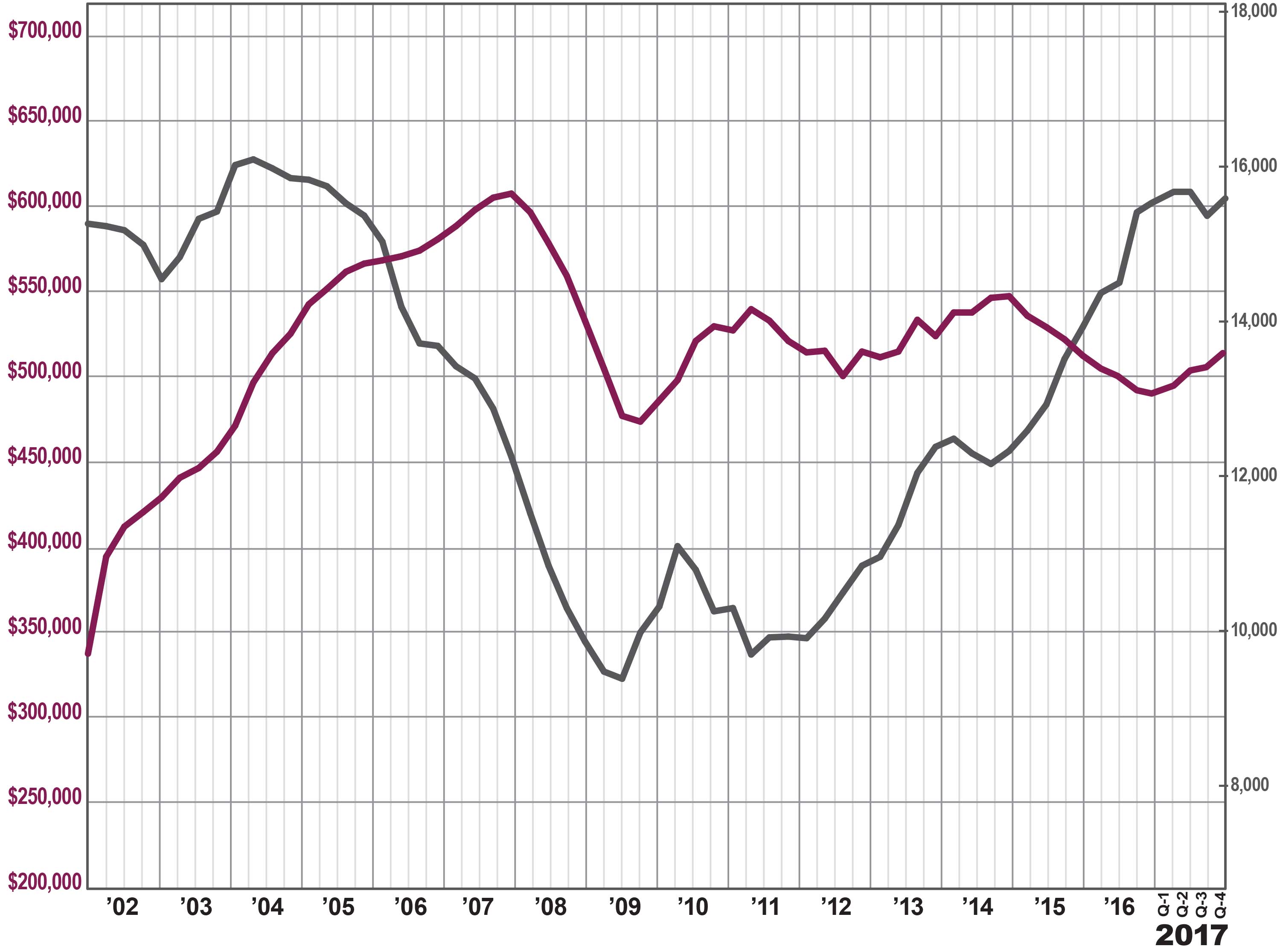
 The housing market in Westchester and the Hudson Valley finished the year strong in the fourth quarter of 2017, with meaningful price appreciation throughout the region driven by low inventory and high demand. Although sales have slumped a bit due to the lack of available homes for sale, rising prices might tempt new sellers to come into this growing seller’s market.
The housing market in Westchester and the Hudson Valley finished the year strong in the fourth quarter of 2017, with meaningful price appreciation throughout the region driven by low inventory and high demand. Although sales have slumped a bit due to the lack of available homes for sale, rising prices might tempt new sellers to come into this growing seller’s market.
Inventory throughout the region continues to fall. Regional inventory was down to 4.6 months. Historically, when inventory drops below the six month level, it usually signals a seller’s market, and many of the individual counties in the region are now at‑or‑below six‑months’ worth of inventory: Westchester single‑family homes are now at 3.5, Putnam at 4.7, Rockland at 4.0, and Orange at 4.7. The lack of inventory continues to stifle sales growth. Regional sales were up for the first time in three quarters, rising almost 6% from the fourth quarter of last year. For all of 2017, sales were up less than 1%, the lowest year‑on‑year increase since 2011. But the problem isn’t lack of buyer demand, which remains strong. Rather, it’s simply that we don’t have enough homes for sale to satisfy the existing demand. Even with the lack of inventory, sales are approaching record highs. The 15,489 regional single‑family home sales in 2017 marked the highest yearly total since 2004, at the height of the last seller’s market. Indeed, sales totals are now almost doubling what we saw at the bottom of the market in 2009. Most significantly, high demand and low inventory are driving meaningful price appreciation. The regional average sales price was up for the fourth quarter in a row, rising almost 3%. We are starting to see long‑term price appreciation, with the regional average price also up 3% for the year. Moreover, appreciation was widespread, with yearlong average prices up in every county in the region: 4% in Westchester, 2% in Putnam, 4% in Rockland, 5% in Orange, and 3% in Dutchess. This is the first time we’ve seen such shared prosperity in over 10 years. Going forward, we believe that prices will continue to appreciate through 2018. Demand is strong, bolstered by near‑historically‑low interest rates, prices that are still near 2003‑04 levels (without controlling for inflation), a generally strong economy, and sharply declining inventory. The question is if we will see sales growth, which will depend on whether homeowners see prices going up and decide to get into this market, bringing fresh new listings to satiate the existing buyer demand. All in all, this is what a seller’s market looks like. High sales totals. Low inventory. Rising prices. All the signs point to an extremely robust 2018 throughout the region. WESTCHESTER
The Westchester housing market finished strong in 2017, with a surge in prices even while a lack of inventory held back sales growth.
Sales. Home sales were up just a tick, rebounding a bit from their sudden decline in the third quarter. You can see the continued impact of a lack of inventory, though, with sales down almost 2% for the full year. Still, with over 6,100 sales for the year, transactions in Westchester are now at their highest level since 2005, and almost double where they were at the bottom of the market in 2009.
Prices. With inventory this low, and demand remaining high, we are starting to see some acceleration in price appreciation. Prices were up 5% on average and at the median for the quarter, and for the year finished up 4% on average and 3% at the median. This is welcome news for Westchester homeowners, who saw small average and median price drops over the past two years. That said, the average and median price are still at 2005 levels, without even accounting for inflation.
Negotiability. The negotiability indicators continue to signal the emergence of the seller’s market. Inventory declined again, falling over 8% and now at the lowest level of inventory we have had in Westchester in over 12 years, since the height of the last seller’s market. Similarly, for the full year, the listing retention rate was up, and the days‑on‑market was down, indicating that homes are selling more quickly and for closer to the asking price.
Condos and Coops. The condo and coop market was more uneven. The condo market was sizzling, with average prices up over 8% in the quarter and almost 5% for the year. Sales were down, but that’s certainly because inventory is below the three‑month level. The coop market was more mixed, with sales up for the year and prices relatively flat, even while inventory fell to the three‑month level.
Going forward, we expect that Westchester will continue to see meaningful price appreciation in 2018, especially if inventory remains tight. With pricing near 2005 levels and interest rates near historic lows, we believe that the seller’s market will thrive in the new year.
To learn more about Better Homes and Gardens Real Estate Rand Realty, visit their website and Facebook page, and make sure to “Like” their page. You can also follow them on Twitter.
Homes in Westchester and the Hudson Valley are STILL Cheaper Than They Have Been in a Generation
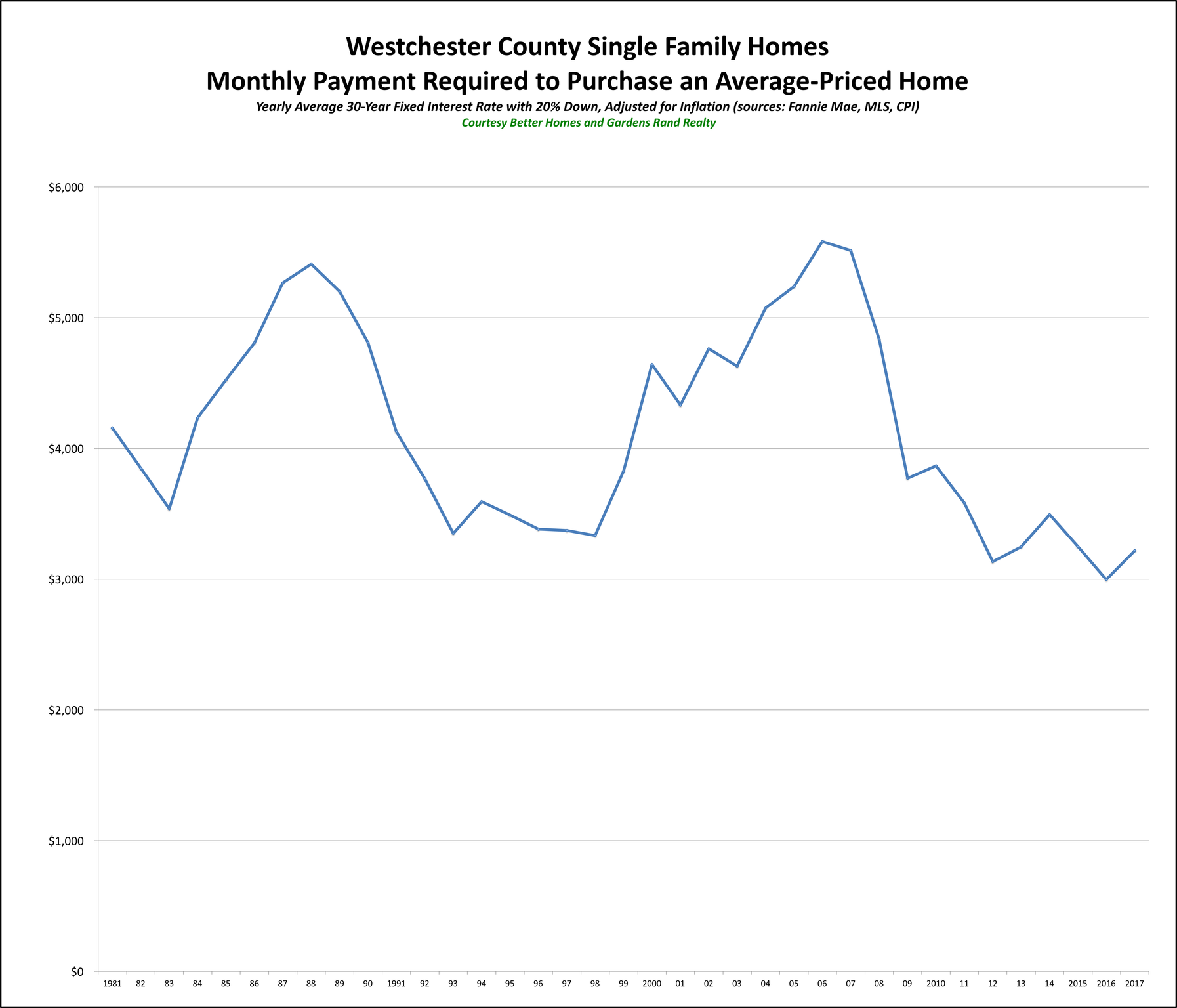
Right now is a really great time to be buying a home in Westchester or the Hudson Valley.
Man, do I hate saying that. As I’ve explained before, I hate the phrase “great time to buy” for a couple of reasons.
First, people have different needs, and a market that’s great for one person might be terrible for another person.
Second, while markets tend to move together, we do see micro-markets (i.e., towns and villages) that defy larger trends. So while it might be a great time to buy in Village A, it might be not so great in Town B.
Third, and most importantly, though, “it’s a great time to buy!” just seems like a hack thing to say, the kind of thing that TERRIBLE real estate agents have said for generations to get unsuspecting and gullible people to buy an overpriced home. And I think that most people get suspicious when real estate agents talk like that.
So I understand if you’re skeptical. And that’s why I don’t want to just TELL you it’s a great time to buy, I want to SHOW you why it’s a great time to buy.
Specifically, I want to make this specific point: the monthly payment you need to buy an inflation-adjusted average priced home in Westchester and the Hudson Valley is as low as its been in a generation.
Think about what I’m saying for a second. I’m NOT saying that homes are cheaper than they’ve ever been. That’s not true. Depending on the year, homes have appreciated, and if you go back more than 15 years, they’ve appreciated pretty dramatically. I’m just saying that the MONTHLY PAYMENT you need to make to buy the AVERAGE PRICED HOME is lower right now than it’s been in a generation — if you control for the effects of inflation.
If you look at the graph below for Westchester County, you’ll see what I mean.

On that graph, as we’ve done before, we’ve plotted the monthly payment that a purchaser in the county would have to make to purchase the average-priced home at various points over the years. After all, affordability is not just a matter of the sales price – it’s a matter of the monthly payment you’re going to have to make, which is partly a function of the prevailing interest rate. And then to measure the change in the monthly payment over time, we factored in the effects of inflation.
So we took the following data points:
•The average price of a single family home up to the end of 2017 – from the local MLS data.
•The average interest rate for a 30-year fixed-rate mortgage for every calendar year up to 2017 – from Freddie Mac.
•The prevailing inflation rate for every calendar year up to 2017– from the US Department of Labor.
You can see the results on the graph. The monthly payment you have to make to purchase the average-priced home in Westchester is just about as low as it’s been in years. We saw the slightest uptick from 2012-2014, partially because of a slight increase in pricing and a slow inflating of interest rates. But the payment came down again over the past two years, with rates falling and prices stalling.
Generally, though, we’re talking about a monthly payment that is as low as anytime in the past 35 years – and as low as it was in the mid-1990s, during a crippling buyer’s market.
So why are monthly payments lower than they’ve been in a generation? A couple of reasons:
1) Prices. Part of it is that we have not seen prices go up in any measurable way in almost 10 years. Home prices peaked in 2006-08, lost about 25-30% of value from 2008-2010, and have bounced around a little since then. But they’re still around 2004 levels — without controlling for inflation.
2) Inflation. Ah, yes, inflation — the value of money goes down a little bit each year as inflation takes a bite. Now, inflation rates have been pretty low over the past 15 years from historical standards, but that little bit each year does add up.
3) Rates. But the biggest reason we’re seeing monthly payments lower than they’ve been in a generation is that rates are still at historic lows. After all, about ten years ago, the average interest rate was about 6%. For the past few years, it’s been below 4%. That’s a huge difference in your monthly payment.
And the same is true throughout the Hudson Valley. I showed you Westchester first because we have good data on prices for the county going back all the way to 1981. In other counties, our data doesn’t go back as far, but if we look at each of those counties you can see that it’s pretty much the same story for the time period we have.
Orange County. Here’s Orange County, where we have data going back to 1994:
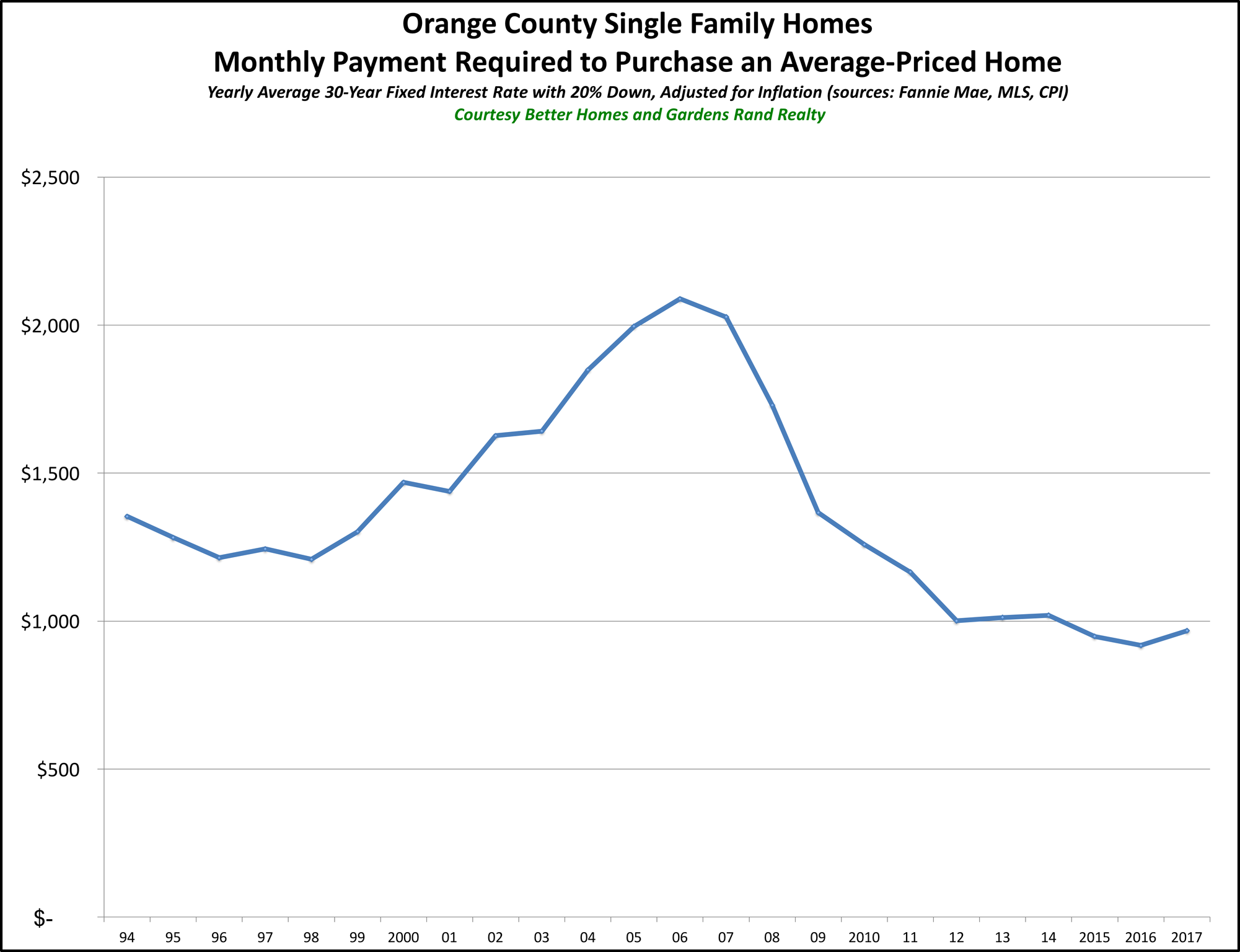
You can see that the monthly payment to buy an average-priced home in Orange County is lower right now than it’s been in over 20 years.
Rockland County. In Rockland, we have data going back to 2002, over 14 years of data.
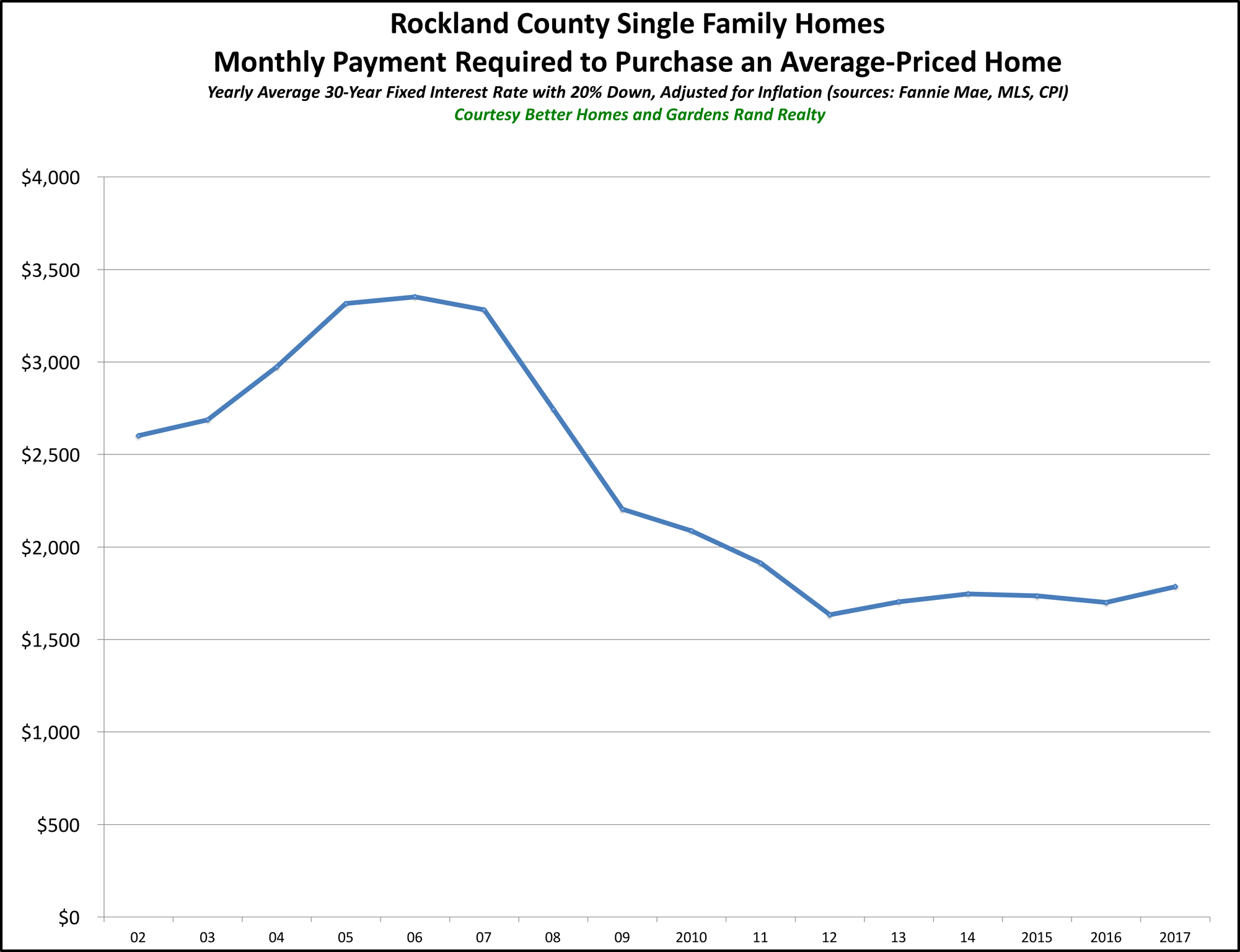
Again, you can see that even with a slight rise in the past few years, the monthly payment you have to make to buy the average-priced home in Rockland is lower right now than it’s been since at least 2002, and probably for quite a bit of time before that.
Putnam County. Similarly, we have data going back to 2002 in Putnam, and the story is the same:
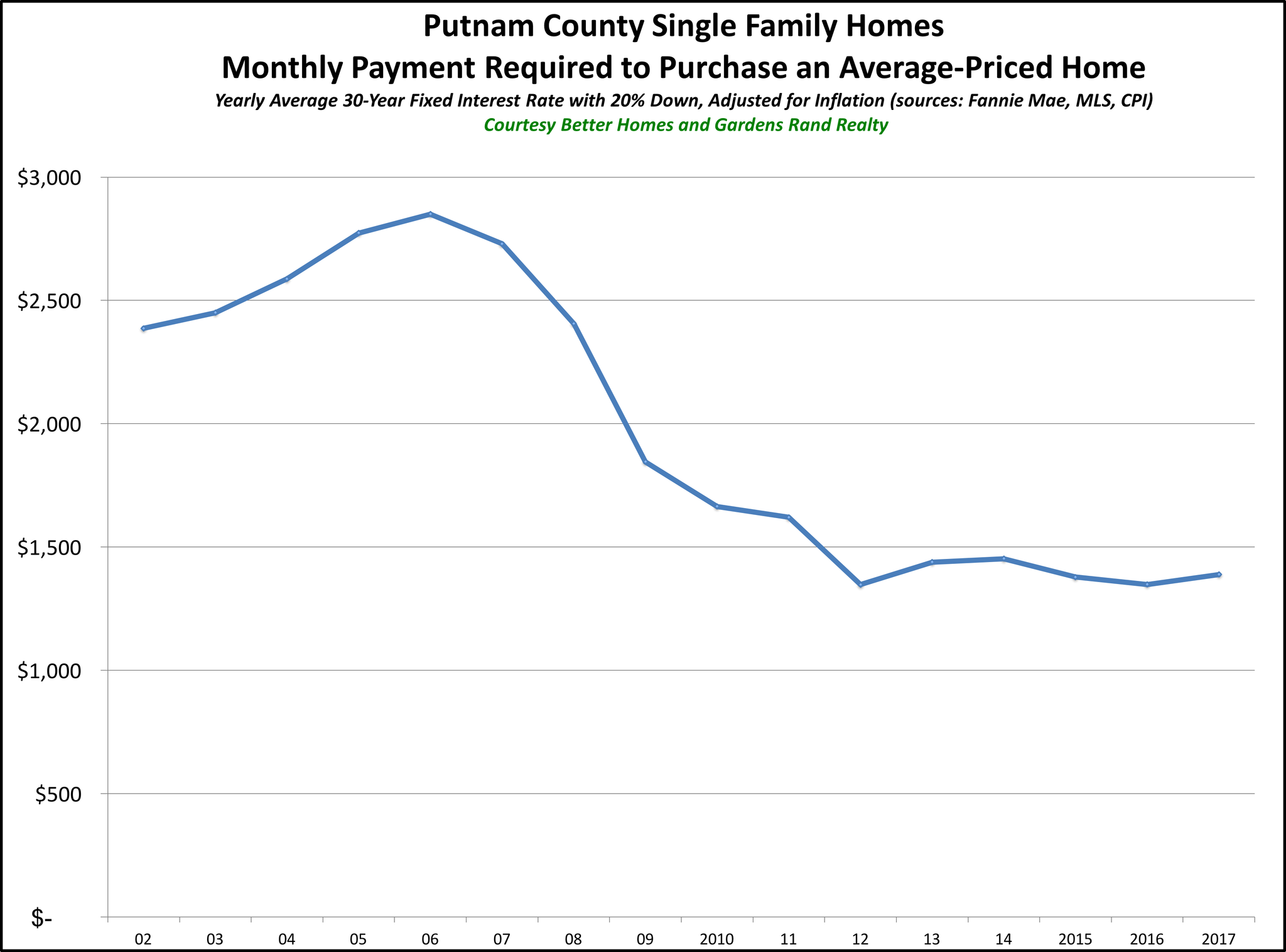
Dutchess County. Again, same story in Dutchess County for that same period:
And although we don’t have data for Orange, Rockland, Putnam, or Dutchess going back as far as Westchester, the fact that the curve over the recent decade or so is very consistent with Westchester’s results suggests that, like in Westchester, the monthly payment you need to make throughout the Hudson Valley is lower right now than it’s been since the Carter administration.
Condos and Coops. All that’s for single-family homes. What about condos and coops? Well, we don’t have data going back as far, but in each county, condos (and coops in Westchester) show the same trend — the monthly payment to buy an average priced condo or coop in the region is lower right now than it’s been at any time since the 2005 era. Here are the graphs:
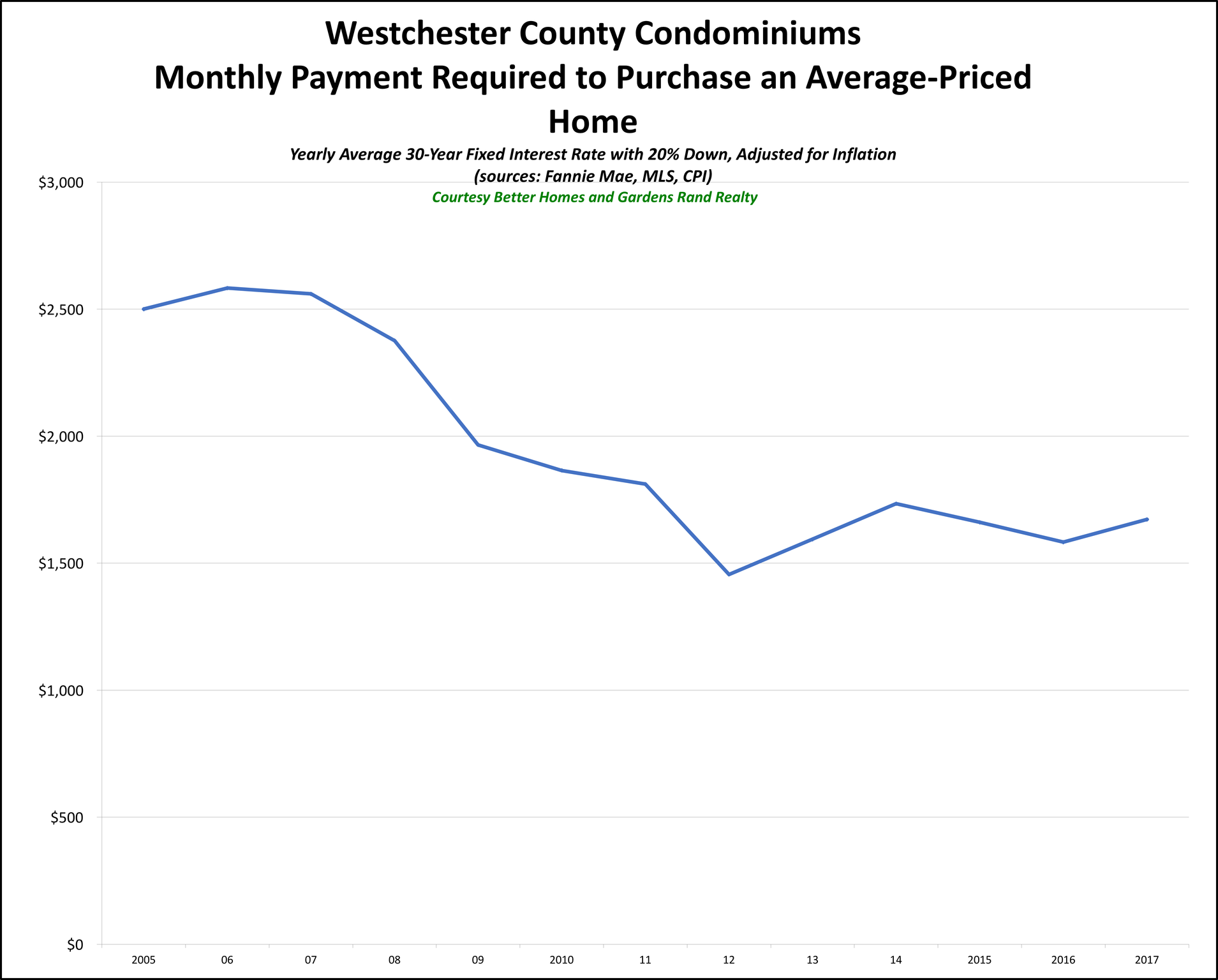
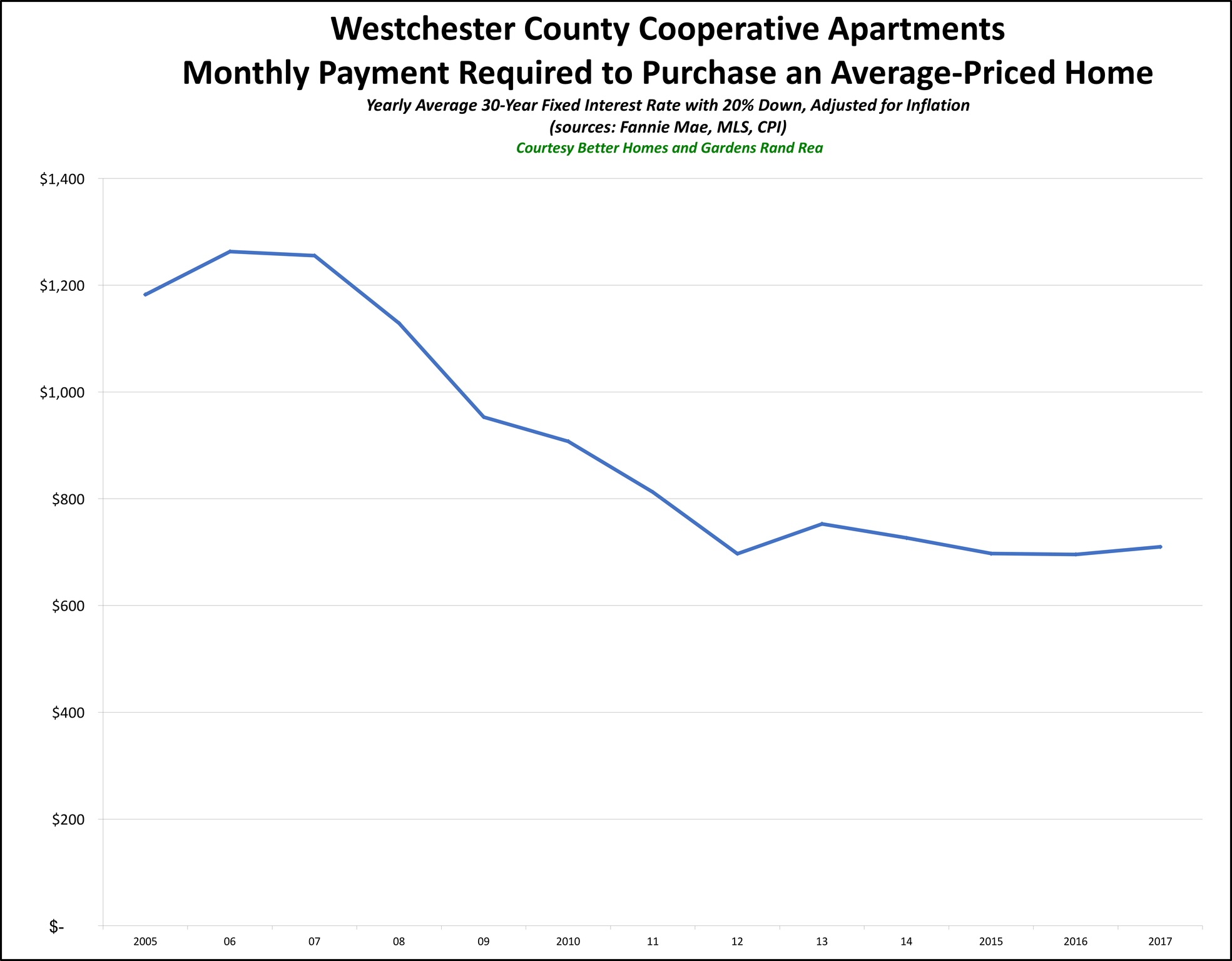
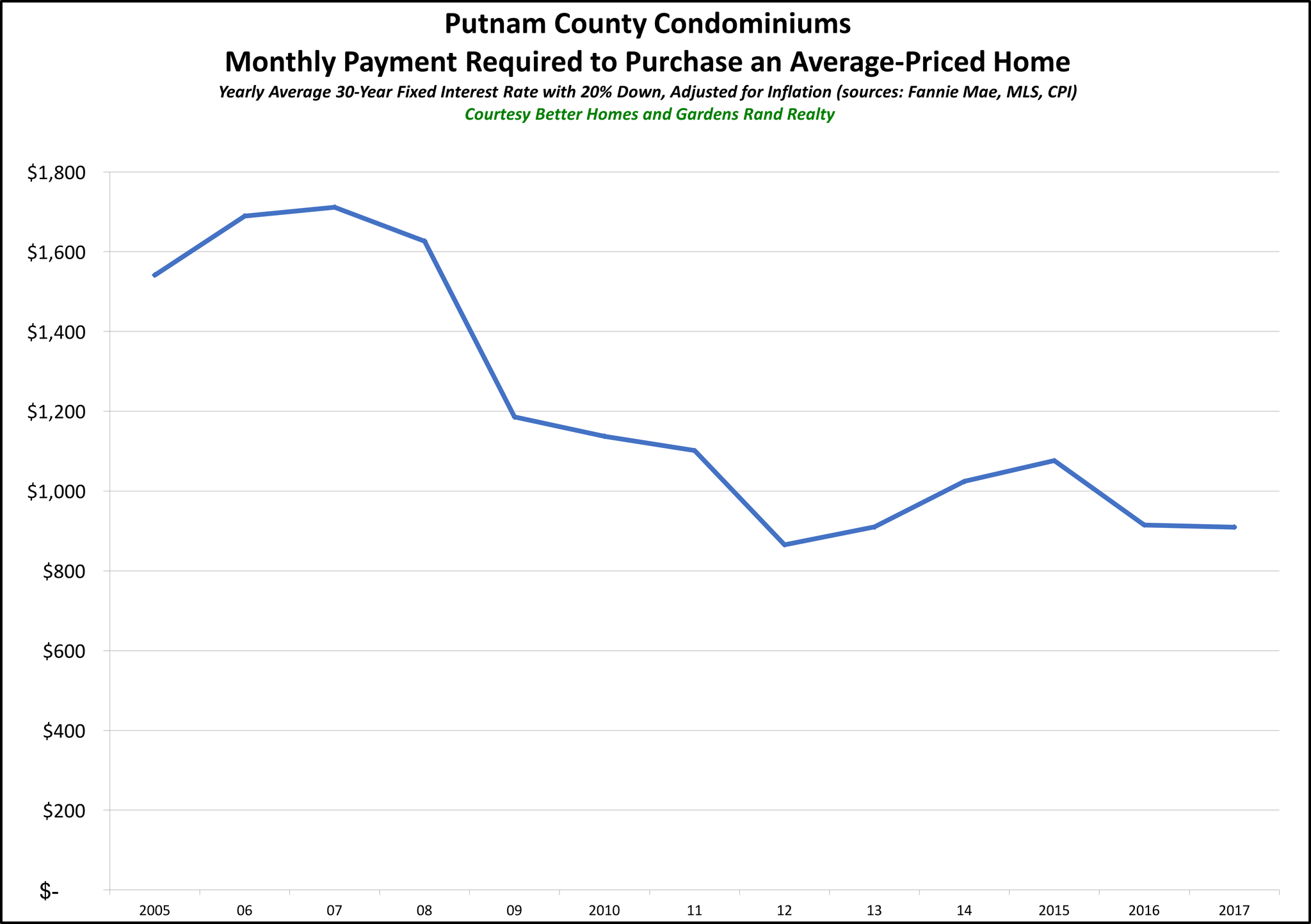
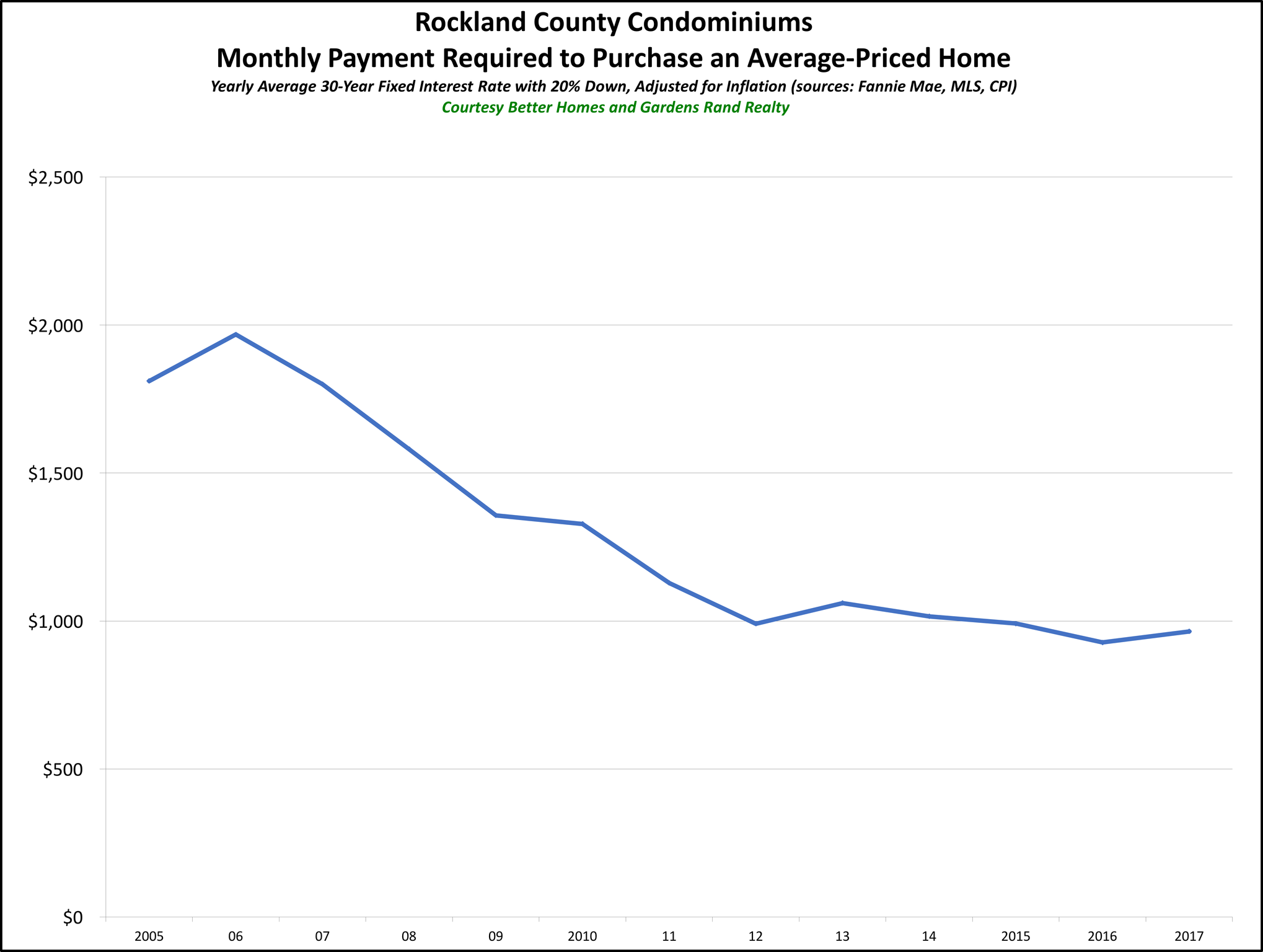
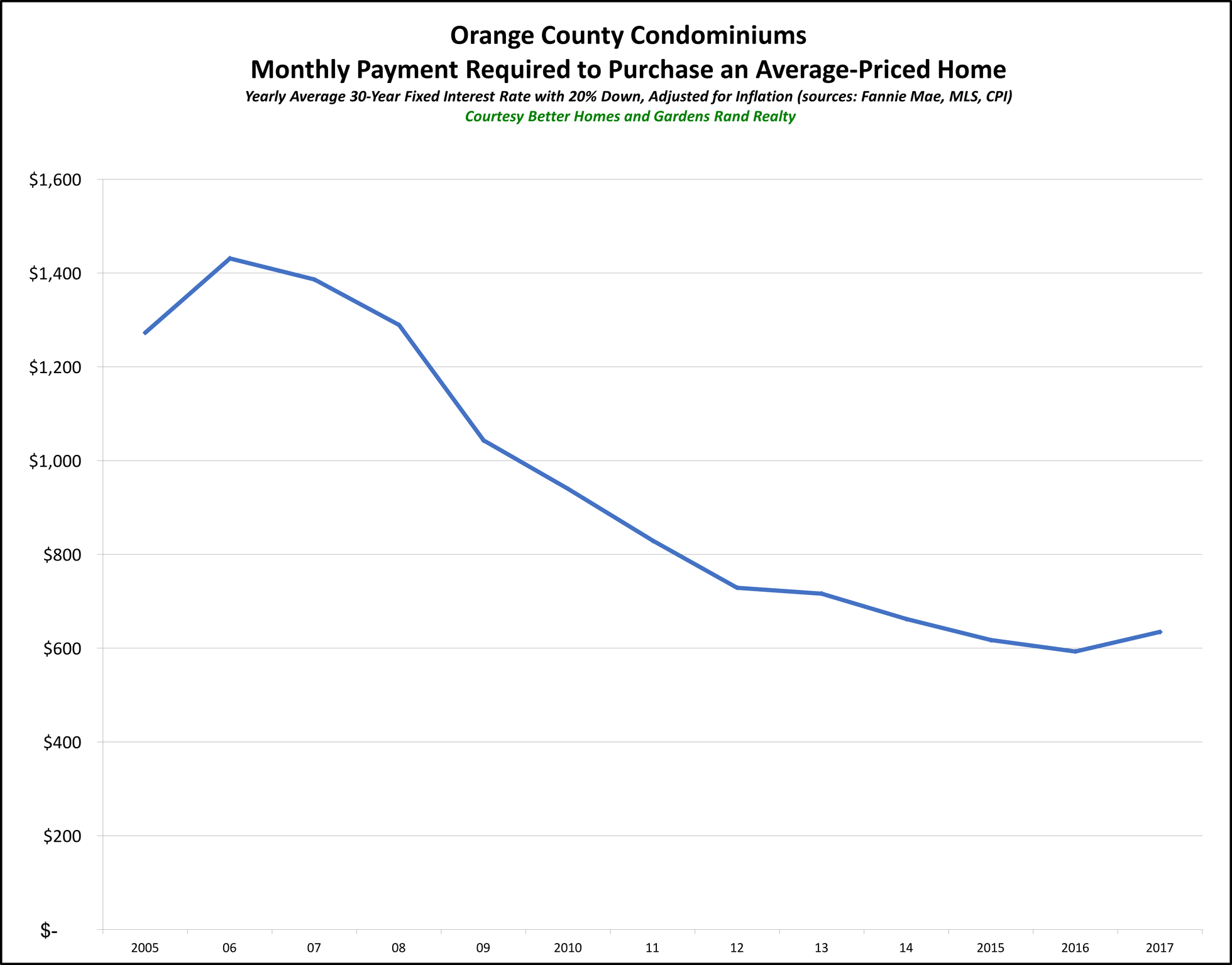
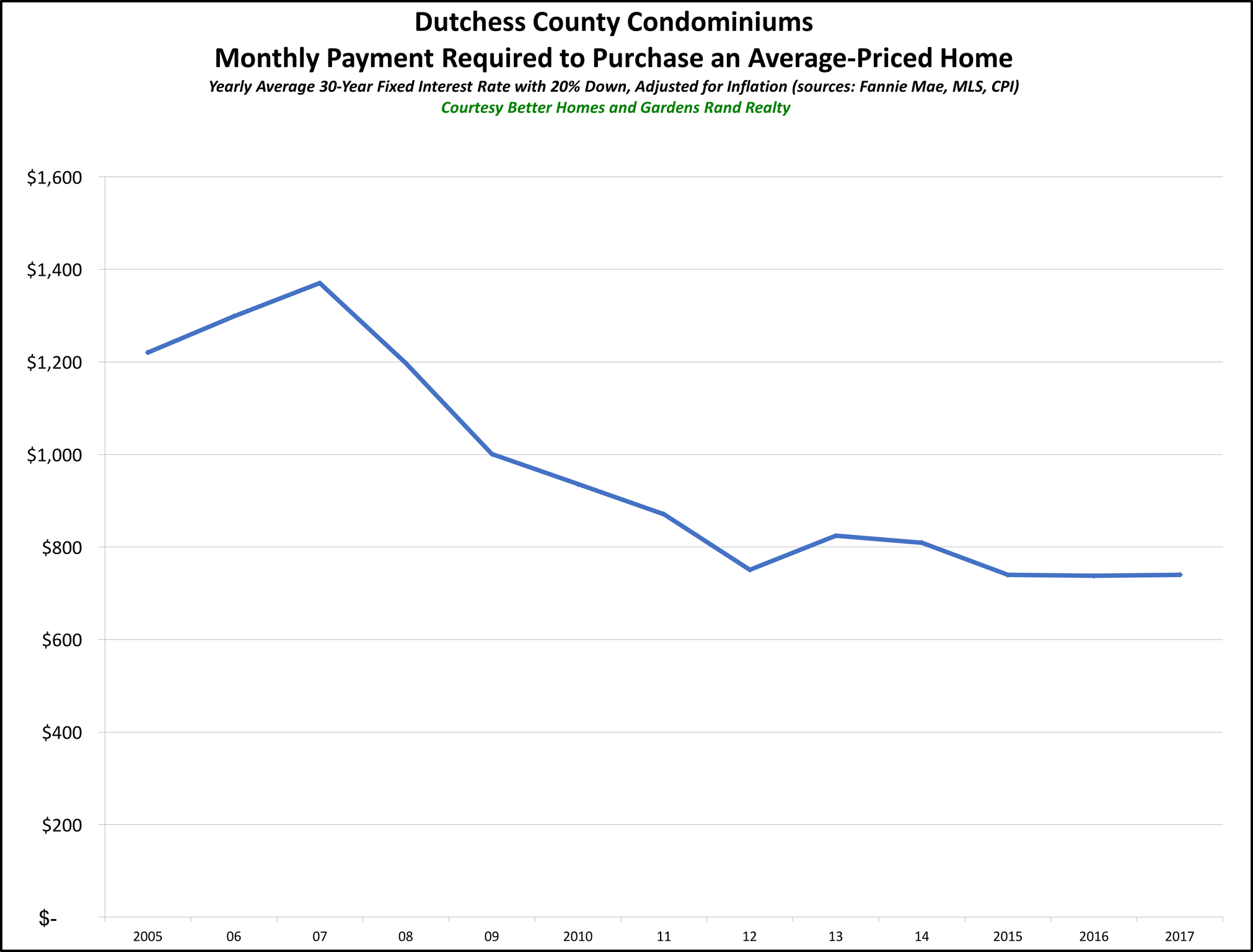
You can see that except for Westchester and Putnam condos, which have seen some pricing changes in the past two years, the monthly payments are lower than any time since 2005. And even in Westchester and Putnam, they’re lower now than at any time in the last decade, just a little higher than the last two years.
We wrote this up last year, and predicted that 2016 would be the last time we’d be able to say it. And we were mostly correct, since prices throughout the region went up a bit, and rates started to creep up. So it’s not quite right to say that 2018 is the best year to buy a home in a generation, since 2917 and 2916might have been better. But you have to otice the trend — the real monthly payment you have to make to buy the average-priced home in our region is lower than it’s been in years.
Conclusion
Again, I HATE it when real estate professionals say that “this is a great time to buy,” because at many times in our history that has been bad advice.
But if you measure a “great time to buy” by looking at the monthly payment you’ll have to make to buy a home, then we’re talking about as good a time to buy as any in the past decades. Prices have been flat for almost 10 years, and they’re down significantly if you factor in the effects of inflation. And interest rates are still as low as we’ve ever seen them. Unless we see some major shock to the economy, I think we’re looking at a near-decade of reasonable price appreciation coupled with increasing interest rates – both of which are going to drive that monthly payment up over the next few years.
So I’m not going to tell you what to do. That’s not my job. But if you’ve been thinking about buying a home, I think these graphs speak for themselves.
To learn more about Better Homes and Gardens Real Estate Rand Realty, visit their website and Facebook page, and make sure to “Like” their page. You can also follow them on Twitter.
Joe Rand is the Chief Creative Officer of Better Homes and Gardens Real Estate | Rand Realty, and compiles and writes the Rand Quarterly Market Report.
Third-Quarter 2017 Market Report: Dutchess County Market Overview

 The Dutchess County housing market showed clear signs of an emerging seller’s market in the third quarter of 2017, with a lack of inventory constricting growth but driving prices up.
The Dutchess County housing market showed clear signs of an emerging seller’s market in the third quarter of 2017, with a lack of inventory constricting growth but driving prices up.
Sales. Dutchess sales were down again in the third quarter, more a reflection of falling inventory in the market than a decline in buyer demand. Sales were down almost 5% for the quarter and are now down over 2% for the rolling year. Dutchess definitely needs some “fuel for the fire” to accommodate strong buyer demand.
Prices. Home prices continued to show the effects of declining inventory coupled with strong demand, with pricing up over 3% on average, 5% at the median, but down almost 12% in the price‑per‑square foot. We can see the same story in the rolling year numbers, with the average price up 2% and the median up over 3%, indicating that Dutchess is moving into a sustained seller’s market.
Negotiability. Dutchess homes are continuing to sell more quickly and for closer to the asking price, reflecting the negotiating leverage that sellers are getting in this market.
Condominiums. The condo market was down after a spike in the second quarter, with sales falling almost 11%. Prices were also down for the quarter, even while the yearlong trend was mostly positive.
Going forward, we believe that the Dutchess market will finish the year strong. With tightening inventory, a stable economy, near‑historically‑low interest rates, and homes still priced at appealing 2003‑04 levels, Dutchess is likely to see meaningful price appreciation through the end of the year and into next year.
To learn more about Better Homes and Gardens Real Estate Rand Realty, visit their website and Facebook page, and make sure to “Like” their page. You can also follow them on Twitter.
Third-Quarter 2017 Market Report: Putnam County Market Overview

 The Putnam County housing market slowed a bit in the third quarter of 2017, with sales falling and prices mixed.
The Putnam County housing market slowed a bit in the third quarter of 2017, with sales falling and prices mixed.
Sales. Putnam single‑family home sales were down almost 10% for the quarter, the third straight quarter of a significant decline in transactions. After over five years of steadily increasing sales, Putnam is now seeing the impact of a lack of inventory, with sales now down 5% for the rolling year.
Prices. This lack of inventory, though, is not driving sustained increases in pricing. Prices were mixed at best: down 3% on average, up a tick at the median, and flat in the price‑per‑square‑foot. We see the same thing in the yearlong trend, with the average down almost 2%, and the median and price‑per‑square‑foot mixed. We have been expecting meaningful appreciation in Putnam for some time now, and still believe that low levels of inventory and stable demand will eventually drive prices up.
Inventory. Inventory continued to tighten, falling over 12% and now down to the six‑month level that usually denotes a tightening seller’s market. This lack of available homes is what’s been restricting sales, since we don’t have enough “fuel for the fire” to keep the market going.
Negotiability. The negotiability indicators support the idea that a seller’s market is emerging, with the listing retention rate up just a tick and the days‑on‑market falling sharply. Homes in Putnam are now selling in about five months from listing to closing.
Condos. The impact of low inventory on the condo market was even more severe, with sales down almost 17%. In this case, though, prices were up sharply, rising 6% on average, almost 5% at the median, and over 1% in the price‑per‑square foot. For the year, though, both sales and prices are down.
Going forward, we believe that Putnam is struggling through some growing pains, but that it will soon start to show the same signs of life that we’re seeing in Westchester and the rest of the Hudson Valley. The fundamentals of the market are tremendous: inventory is low, rates are near historic lows, and prices are still at attractive 2004‑05 levels. We think that meaningful price appreciation in Putnam is just a matter of time.
To learn more about Better Homes and Gardens Real Estate Rand Realty, visit their website and Facebook page, and make sure to “Like” their page. You can also follow them on Twitter.
Third-Quarter 2017 Real Estate Market Report: Orange County Market Overview
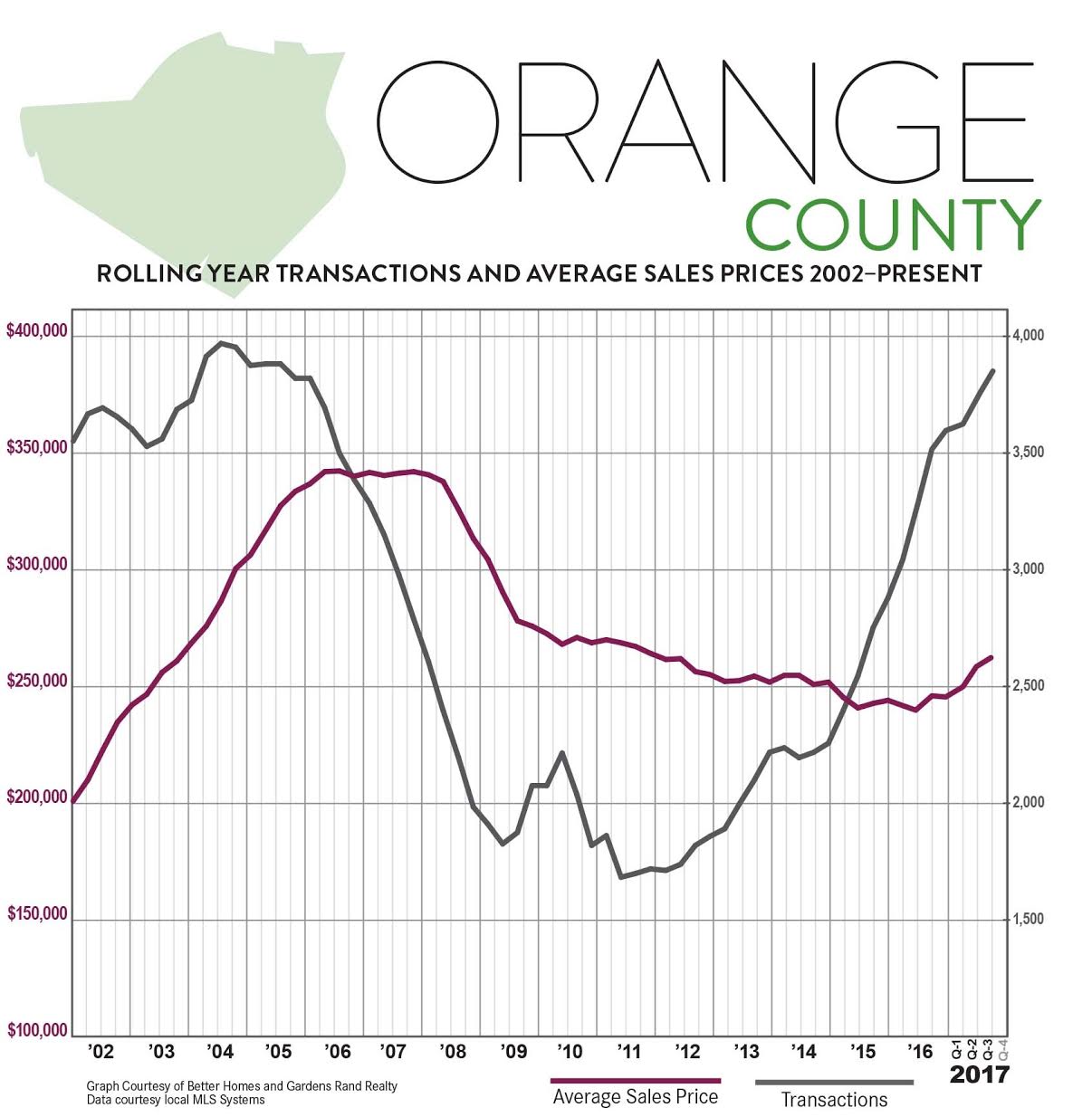
 The Orange County housing market surged again in the third quarter of 2017, with both sales and prices up while inventory continued to fall.
The Orange County housing market surged again in the third quarter of 2017, with both sales and prices up while inventory continued to fall.
Sales. Orange sales were up yet again, rising over 6% from last year’s third quarter. Quarterly transactions have now gone up in 12 straight quarters and 21 out of the last 22. Indeed, for the rolling year, sales were up almost 10%, and the 3,722 single‑family sales were the highest total we have seen since the height of the last seller’s market.
Prices. These sustained levels of buyer demand are finally having a meaningful impact on pricing. Home prices rose again in the third quarter, up a tick on average and almost 5% at the median (although down slightly in the price‑per‑square‑foot). And home prices are now showing meaningful signs of appreciation over the longer‑term, with the rolling year prices up almost 4% on average, over 5% at the median, and almost 2% in the price‑per‑square foot.
Negotiability. The available inventory continues to tighten, down over 22% and now down to the six‑month level that starts to signal a seller’s market. Meanwhile, homes are selling more quickly and for closer to the asking price, with the days‑on‑market falling and the listing retention rate rising. Homes are now selling in almost five months from listing to closing.
Condominiums. The condo market was also up sharply, continuing a welcome trend that we finally started to see this year. Sales were up almost 15%, and prices were up over 1% on average and almost 7% at the median. The rolling year pricing showed that this is now a longer‑term trend: up 4% on average, over 5% at the median, and over 3% in the price‑per‑square foot.
Going forward, we believe that the Orange County housing market is poised for a great year: demand is high, prices are still at attractive 2003‑04 levels, interest rates are at historic lows, and the economy is generally strong. With inventory continuing to decline, we expect to see meaningful price appreciation through the rest of 2017 and into 2018.
To learn more about Better Homes and Gardens Real Estate Rand Realty, visit their website and Facebook page, and make sure to “Like” their page. You can also follow them on Twitter.

 Facebook
Facebook
 X
X
 Pinterest
Pinterest
 Copy Link
Copy Link
